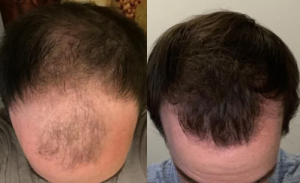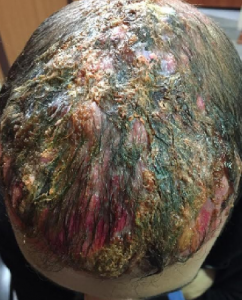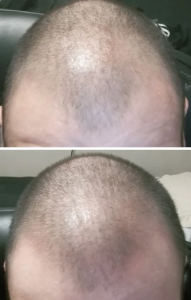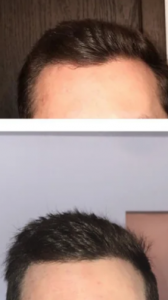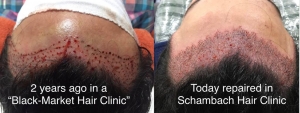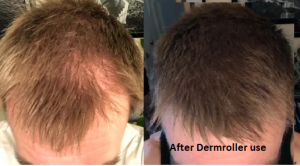I suspect that this man may have had this surgery performed in a less than clean clinic with unskilled people who may not have been doctors and didn’t understand sterility as a concept. I don’t know the outcome but as a doctor in Europe sent on this photo, I suspect that this man will be treated properly now. This photo should be a warning to those in my readership who shop for bargain hair transplants in Turkey (there are good doctors in Turkey but they don’t charge $1/graft or less). This, regardless of the price this man paid for his bargain hair transplant, it will be a most expensive hair transplant to get him back to where he needs to be. His looks and his health are on the line.
The red you see is blood draining from green and yellow pus pockets. This man has many ‘boils’ or infected cysts possibly starting from a hair graft. Each one of these need to have a surgeon drain them. Once they are all drained and the bacteria cultured, the patient will be put on antibiotics and as new infected cysts appear, they will be drained again. Eventually good surgical draining and antibiotics will calm this down. He will have some scarring left and most of the hair grafts will probably die. Once he is recovered, a good surgeon will reassess his donor supply and hopefully he might have enough donor hair to redo the transplant. This process from infection to a new hair transplant could take up to a year.
The article reported “total lack of scalp hair – along with eczema, experienced significant hair regrowth while being treated with dupilumab, a drug marketed under the brand name Dupixent”.
Here is the article: https://www.eurekalert.org/pub_releases/2018-10/mgh-edr100718.php
Why can’t the procedure be done under general anesthesia, to avoid the shock loss associated with the local anesthesia and the epinephrine used with the local anesthesia?
General anesthesia has risks that local anesthesia doesn’t have (the death rate is about 1:20,000 people). In addition, hair transplants are very long procedures, and general anesthesia would cost a lot of money for 8 hours and put you at more risk than needed.
So I am 31/M and have been considering a hair transplant. Not going to get into the details too much but every site I have seen the ‘success’ photos are dudes with major black and thick hairs and any that I have seen that would be considered thin follicle hair just look like they have added on a couple more years before you have to shave it anyway.
So I am asking is there anyone here who has what you would call ‘thin’ hair had a successful hair transplant that doesn’t look completely terrible?
I use a construction metaphor for explaining fine hair vs a coarser hair. Think of fine has as lumbar 1 by 1, and medium hair as lumbar 2 by 2 and coarse hair as lumber of 4 by 4. If you were to build a fence, you would opt for 4 by 4 first for the fence as there is more wood in a 4 by 4 than a one by one. Fine hair reflects a one by one measurement of lumber and a fence made of 1 by 1’s take more 1 by 1’s than if you had 4 by 4 wood boards. A hair transplant with fine hair means that less hair volume will be moved per hair shaft transplanted. Men with fine hair always had fine hair, so that they are not surprised when then get a hair transplant with their own fine hair. I just don’t want a new patient to expect that they will get the results of a man with coarse hair if they get a hair transplant with me. Setting realistic expectation is what it is all about.
I am thinking about getting a transplant, FUE from turkey as its all I could afford. I am 23 and at Norwood 3 and its killing my confidence. When I was 18 I could honestly get any girl I wanted, Now I look like a meth head with how far my temples have receded. Going bald is not an option as I have a “bubble head” In short I look hella ugly without hair, whereas back in the day before my hair started to go I was regularly told I was hot. Is a hair transplant for life? What do I have to do after the transplant? Where is the best place to get one?
23 is too young to have a hair transplant. There is a wonderful post earlier today which covers the 10 things you need to know about hair transplants and I would recommend it. If you go to Turkey, they are known for depleting your donor area and leaving you with not enough hair to manage the progressive nature of male pattern balding (see here:https://baldingblog.com/need-master-plan-think-hair-transplants-photos/ ). This could be you in a few years, so what you do today is critically important to your future.
Does everyone’s hair (people with zero balding) go back a little at the temples?
95% of Caucasian men develop a mature hairline. changing the shape from a rounded juvenile hairline to a V shaped hairline which usually moves up about 3/4″ from the original juvenile position. In many other races (Arab, From India) the juvenile hairline may remain.
Many times finasteride just slows down or stops the hair loss without reversal. That is hard to see.
I am 24 years old guy who started losing hair 2 years ago I remember not long time after the girl I loved left me for another guy, anyways I’ve been obsessed with my hairloss for a long time, it was killing me mentally everyday, and making me depressed and sad, losing will and motivation to do anything in life. I have been using Finasteride since 07.08.2018(exactly year ago). and I missed a dose or two over a whole year. Final review? It didn’t work for me unfortunately . I’ve lost a lot more hair then I had exactly a year ago. I have always seen comments on this site, over this year for how long I’ve been on it, comments like “I never saw a thread from some guy saying he still lost hair on Finasteride, everybody halts hairloss or even regrows, Finasteride works like 100%”. Well then I didn’t make it brothers, sadly…. Maybe I should consider Dutasteride?
You have to have a good doctor to discuss this with. Dutasteride is something that many doctors don’t prescribe because it is not FDA approved for hair loss. Have you considered what you would do if dutasteride didn’t work? A good doctor can keep hair on you, one way or the other. Hair transplants always work as an option that many take.
Although the literature suggests that there could be a link (as with most medications), a family member of mine uses Propranolol when he goes into meetings, before going into the public or for periods when he gets heavily stressed, and has not experienced hair loss. I think in such situations, this drug will not have a significant risk of hair loss.
I have been asked how this can happen. We are now doing extensive research into wound healing and the appearance of hair after a wound has healed. This man grew hair from the sides of his burn wound (my assessment of the photos) and this new skin brought along with it hair follicles that clearly were different than his balding follicles which had disappeared prior to the burn. In our experimental work, we have created such wounds and found hair growth not-infrequently. This is the theory behind microneedling that is now performed regularly by many men with good results. The wound created by the microneedling go down to the depth of the stem cells (1-1.5mm below the skin) and with persistent wounding, hair is stimulated through the impact on the stem cells reached by the needling. This was shown in the previous post on this blog.
https://www.ncbi.nlm.nih.gov/pmc/articles/PMC1351888/pdf/bmjcred00266-0059a.pdf
After years of using Finasteride + Minoxodil, my thinning got worse in January. So I added a dermaroller 1.5 mm every 7-10 days. Major progress in 6 months!
Nice improvement. There is no doubt that the use of a dermroller induces wound healing which brings on hair growth to those who recently lost the hair. Add that to the finasteride that held on to your hair, and you are a fortunate man.
Page 213 of 641

